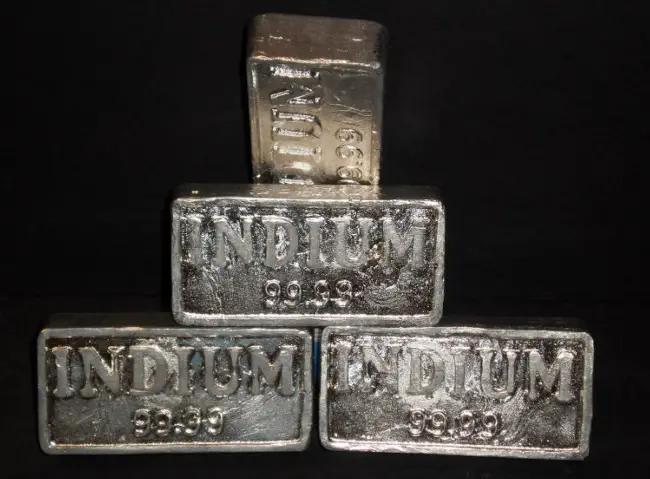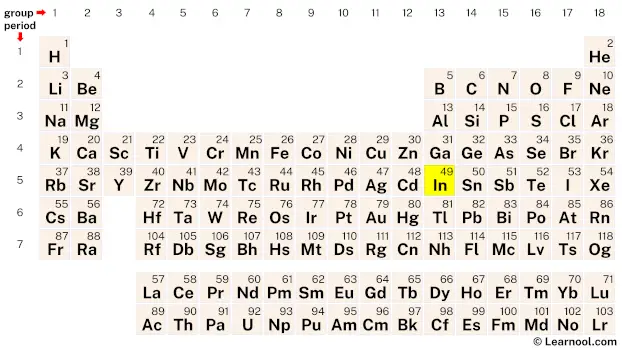
Indium (In) is a chemical element of the periodic table, located in the group 13 and the period 5, and is having the atomic number 49. It is a soft, lustrous, silvery-white post transition metal, whose name comes from the Latin word “indicium”, which means violet or indigo. It is a member of the boron group.
On periodic table
| group | ⇨ | 1 | 2 | 3 | 4 | 5 | 6 | 7 | 8 | 9 | 10 | 11 | 12 | 13 | 14 | 15 | 16 | 17 | 18 |
| period | ⇩ | ||||||||||||||||||
| 1 | 1 H  Hydrogen |
2 He  Helium |
|||||||||||||||||
| 2 | 3 Li  Lithium |
4 Be  Beryllium |
5 B  Boron |
6 C  Carbon |
7 N  Nitrogen |
8 O  Oxygen |
9 F  Fluorine |
10 Ne  Neon |
|||||||||||
| 3 | 11 Na  Sodium |
12 Mg  Magnesium |
13 Al  Aluminium |
14 Si Silicon |
15 P  Phosphorus |
16 S  Sulfur |
17 Cl  Chlorine |
18 Ar  Argon |
|||||||||||
| 4 | 19 K  Potassium |
20 Ca  Calcium |
21 Sc  Scandium |
22 Ti  Titanium |
23 V  Vanadium |
24 Cr  Chromium |
25 Mn  Manganese |
26 Fe  Iron |
27 Co  Cobalt |
28 Ni  Nickel |
29 Cu  Copper |
30 Zn  Zinc |
31 Ga  Gallium |
32 Ge  Germanium |
33 As  Arsenic |
34 Se  Selenium |
35 Br  Bromine |
36 Kr  Krypton |
|
| 5 | 37 Rb  Rubidium |
38 Sr  Strontium |
39 Y  Yttrium |
40 Zr  Zirconium |
41 Nb  Niobium |
42 Mo  Molybdenum |
43 Tc  Technetium |
44 Ru  Ruthenium |
45 Rh  Rhodium |
46 Pd  Palladium |
47 Ag  Silver |
48 Cd  Cadmium |
49 In Indium |
50 Sn  Tin |
51 Sb  Antimony |
52 Te  Tellurium |
53 I  Iodine |
54 Xe  Xenon |
|
| 6 | 55 Cs  Caesium |
56 Ba  Barium |
72 Hf  Hafnium |
73 Ta  Tantalum |
74 W  Tungsten |
75 Re  Rhenium |
76 Os  Osmium |
77 Ir  Iridium |
78 Pt  Platinum |
79 Au  Gold |
80 Hg  Mercury |
81 Tl  Thallium |
82 Pb  Lead |
83 Bi  Bismuth |
84 Po  Polonium |
85 At  Astatine |
86 Rn  Radon |
||
| 7 | 87 Fr  Francium |
88 Ra  Radium |
104 Rf  Rutherfordium |
105 Db  Dubnium |
106 Sg  Seaborgium |
107 Bh  Bohrium |
108 Hs  Hassium |
109 Mt  Meitnerium |
110 Ds  Darmstadtium |
111 Rg  Roentgenium |
112 Cn  Copernicium |
113 Nh  Nihonium |
114 Fl  Flerovium |
115 Mc  Moscovium |
116 Lv  Livermorium |
117 Ts  Tennessine |
118 Og  Oganesson |
||
| 57 La  Lanthanum |
58 Ce  Cerium |
59 Pr  Praseodymium |
60 Nd  Neodymium |
61 Pm  Promethium |
62 Sm  Samarium |
63 Eu  Europium |
64 Gd  Gadolinium |
65 Tb  Terbium |
66 Dy  Dysprosium |
67 Ho  Holmium |
68 Er  Erbium |
69 Tm  Thulium |
70 Yb  Ytterbium |
71 Lu  Lutetium |
|||||
| 89 Ac  Actinium |
90 Th  Thorium |
91 Pa  Protactinium |
92 U  Uranium |
93 Np  Neptunium |
94 Pu  Plutonium |
95 Am  Americium |
96 Cm  Curium |
97 Bk  Berkelium |
98 Cf  Californium |
99 Es  Einsteinium |
100 Fm  Fermium |
101 Md  Mendelevium |
102 No  Nobelium |
103 Lr  Lawrencium |
|||||
| – p block |
Indium is a p-block element, situated in the thirteenth column (boron group) of the periodic table, between cadmium (Cd) and tin (Sn). It has the atomic number 49 and is denoted by the symbol In.
Element information
 |
|
 |
|
| Origin of name | Latin word “indicium” (which means violet or indigo) |
| Symbol | In |
| Atomic number (Z) | 49 |
| Atomic mass | 114.818 u |
| Block | p-block |
| Group | 13 (boron group) |
| Period | 5 |
| Classification | Post-transition metal |
| Atomic radius | 167 pm |
| Covalent radius | 142±5 pm |
| Van der Waals radius | 193 pm |
| Melting point | 156.5985 ℃, 313.8773 ℉, 429.7485 K |
| Boiling point | 2072 ℃, 3762 ℉, 2345 K |
| Electron configuration | [Kr] 4d10 5s2 5p1 |
| Electrons per shell | 2, 8, 18, 18, 3 |
| Learn how to draw: Indium Bohr model | |
| Crystal structure | Body-centered tetragonal |
| Phase at r.t | Solid |
| Density near r.t | 7.31 g/cm3 |
| Main isotopes | Indium-113 |
| Natural occurrence | Primordial |
| Oxidation state | +3 |
| Electronegativity (Pauling scale) | 1.78 |
| Protons Neutrons Electrons |
49 66 49 |
| Learn how to find: Indium protons neutrons electrons | |
| Valence electrons | 3 |
| Learn how to find: Indium valence electrons | |
| CAS number | 7440-74-6 |
| Discovered by | Ferdinand Reich and Hieronymous Theodor Richter in 1863 |
History
Indium was discovered by Ferdinand Reich and Hieronymous Theodor Richter in 1863, in Germany. The name “indium” originates from the indigo blue line in its spectrum that was observed during its discovery. Reich and Richter first isolated indium from a blend of zinc and lead ores. They named the element “indium” after its indigo blue spectral emission lines. The element was first isolated in pure form in 1869 by German chemist Clemens Winkler.
Winkler found the new element in sphalerite (ZnS) and discovered its properties by an analysis of its salts. He named it after the color indigo. It was later proved that Reich and Richter’s claimed discovery of the element was contaminated by the presence of the element thallium, which led to its incorrect atomic weight. The discovery of indium was an important step in the development of the periodic table, as its location in the table helped fill a gap in the sequence of elements predicted by Mendeleev. Indium’s unique properties make it a valuable material in the electronics and manufacturing industries.
Occurrence and production
Indium is a rare element in the Earth’s crust, occurring at an average abundance of about 0.1 parts per million. It is usually found in small amounts as a trace mineral within other ores, such as sulfides, ores of tin, zinc, and copper. The largest indium reserves are found in China, South Korea, Canada, and Japan.
Indium is mainly produced from zinc and lead ores that contain it as a minor component. The extraction of indium involves the processing of these ores through a series of steps that typically involve roasting, leaching, and electrolysis. The resulting crude indium is then refined using vacuum distillation to produce pure indium metal.
Indium is also a byproduct of other mining processes, such as copper, tin, and polymetallic mining. The recycling of electronic waste and the recovery of indium from thin-film solar cells have become important sources of indium in recent years. As a result, the availability of indium has increased, and the cost has decreased, making it more accessible for use in various industries.
Properties
Indium is a silvery-white, soft and malleable metal.
It has a low melting point of 156.59 ℃, which makes it useful for low-temperature applications.
It is a relatively dense metal with a density of 7.31 g/cm3.
Indium is a good conductor of both heat and electricity.
It is non-toxic, which makes it useful for certain medical applications.
Indium has a high coefficient of thermal expansion, meaning it expands significantly when heated.
It has good corrosion resistance, even when exposed to air and water.
Indium is paramagnetic, which means it is weakly attracted to magnetic fields.
Applications
Semiconductor industry
Indium is an essential component in the production of semiconductors, including transistors, diodes, and integrated circuits. It is used as a dopant in silicon to increase its electrical conductivity, and as a solder in bonding electronic components.
LCD displays
Indium tin oxide (ITO) is a transparent and electrically conductive material that is used in the production of liquid crystal displays (LCDs) for electronic devices such as televisions, smartphones, and tablets.
Solar cells
Indium is used in the production of thin-film solar cells as a component of copper indium gallium selenide (CIGS) absorber layers. CIGS solar cells have a high efficiency rate and are lightweight, making them ideal for use in portable devices.
Medical imaging
Indium-111 is a radioactive isotope that is used in nuclear medicine for imaging purposes. It is used to locate tumors and inflammation in the body, as well as to diagnose certain infections.
Nuclear industry
Indium is used in the nuclear industry as a neutron absorber in control rods for nuclear reactors. It is also used in the production of radioisotopes for medical and industrial applications.
Interesting facts
Indium is named after its indigo blue spectral line, which was discovered by Ferdinand Reich and Hieronymous Theodor Richter in 1863. The name “indium” refers to the color indigo.
Indium is a soft, silvery-white metal that is highly malleable and ductile. It is also a very dense metal, with a density of 7.31 grams per cubic centimeter.
Indium has a low melting point of 156.59 degrees Celsius, which makes it useful in a variety of applications such as solders, low-temperature alloys, and as a component in liquid crystal displays (LCDs).
Indium is also a good conductor of both heat and electricity. It is used as a component in some high-performance electronics, including semiconductors and photovoltaic cells.
Indium has a unique property known as “indium wetting,” which allows it to adhere to many different surfaces. This property makes it useful as a coating material for glass and other materials, as well as in the production of mirror surfaces.
Indium is a rare element, accounting for only about 0.25 parts per million of the Earth’s crust. It is typically found in minerals such as sphalerite, which is a zinc sulfide ore, and as a trace element in other minerals.
The largest producers of indium are China, Japan, South Korea, and Canada. In recent years, there has been concern about the future availability of indium due to increasing demand from the electronics industry.
Indium has no known biological role, but it is not toxic and is not considered to be harmful to humans or the environment.
Indium has some interesting physical properties, including a very low vapor pressure and a low boiling point. These properties make it useful in vacuum-sealed environments and in the production of specialized vacuum equipment.
In addition to its use in electronics, indium has some potential applications in medicine. Research is currently being conducted to explore its use in cancer treatment, as well as its potential as an antimicrobial agent.
Related
More elements
External links
- https://www.rsc.org/periodic-table/element/49/indium
- https://en.wikipedia.org/wiki/Indium
- https://www.britannica.com/science/indium
- https://www.livescience.com/37352-indium.html
- https://www.chemicool.com/elements/indium.html
- https://pubchem.ncbi.nlm.nih.gov/element/Indium
- https://education.jlab.org/itselemental/ele049.html
- https://www.acs.org/content/acs/en/greenchemistry/research-innovation/endangered-elements/indium.html
Deep
Learnool.com was founded by Deep Rana, who is a mechanical engineer by profession and a blogger by passion. He has a good conceptual knowledge on different educational topics and he provides the same on this website. He loves to learn something new everyday and believes that the best utilization of free time is developing a new skill.
